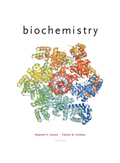
Concept explainers
Answers to all problems are at the end of this book. Detailed solutions are available in the Student Solutions Manual, Study Guide, and Problems Book.
Assessing the Effect of pH on
Want to see the full answer?
Check out a sample textbook solution
Chapter 3 Solutions
EBK BIOCHEMISTRY
- Hair grows at a rate of about 20 cm/yr. All this growth is concentrated at the base of the hair fiber, where a-keratin filaments are synthesized inside living epidermal cells and assembled into ropelike structures. Two-chan 14 Protofilament 20-30 A Two-chain Intermediate flament -Protob Protofilament Cross section of a hair The fundamental structural element of a keratin is the a helix, which has 3.6 amino acid residues per turn and a rise of 5.4 A perlum. 54A (36) Amino terminus Carbon Hydrogen Oxygen Nitrogen group Carboxyl terminus Assuming that the biosynthesis of a helical keratin chains is the rate-limiting factor in the growth of hair, calculate the rate at which peptide bonds of a-keratin chains must be synthesized (peptide bonds per second) to account for the observed yearly growth of hair. 0422 rate of peptide bond formation: Income bonds/sarrow_forwardSpecific rotation is a measure of a solution's capacity to rotate circularly polarized light. The unfolding of the a helix of a polypeptide to a random conformation is accompanied by a large decrease in specific rotation. Polyglutamate, a polypeptide made up of only 1-Glu residues, has the a helix conformation at pH 3. When researchers raise the pH to 7, there is a large decrease in the specific rotation of the solution. Similarly, polylysine (1.-Lys residues) is an a helix at pH 10, but when researchers lower the pH to 7 the specific rotation also decreases, as shown in the graph. a Helix Specific rotation Poly(Glu) a Helix Random conformation Poly(Lys) Random conformation T + ° 2 4 6 В 10 12 14 PH Complete the statements about the molecular mechanism for these changes in specific rotation. Increasing the pH of a polyglutamate solution from 6 to 7 causes the carboxyl group of each glutamate residue Comed Artwer lose a proton. The negatively charged groups in each glutamate residue…arrow_forwardFrom the reaction data below, determine whether the reaction is first order or second order and calculate the rate constant. Time (s) 0 Reactant (mM) 6.2 1 3.1 2 2.1 3 1.6 4 1.3 5 1.1 Only a plot of 1/[reactant] versus t gives a straight line, so the reaction is 0.150 mM-1 s-1 . S second order . The slope, k, isarrow_forward
- From the reaction data below, determine whether the reaction is first order or second order and calculate the rate constant. Time (s) 0 Reactant (mM) 5.4 1 4.6 2 3.9 3 3.2 4 2.7 5 2.3 Only a plot of In[reactant] versus t gives a straight line, so the reaction is s-1. . The negative of the slope, k, isarrow_forwardA protein has a molecular mass of 400 kDa when measured by size-exclusion chromatography. When subjected to gel electrophoresis in the presence of sodium dodecyl sulfate (SDS), the protein gives three bands with molecular masses of 180, 160, and 60 kDa. When electrophoresis is carried out in the presence of SDS and dithiothreitol (DTT), three bands again form, this time with molecular masses of 160, 90, and 60 kDa. How many subunits does the protein have, and what is the molecular mass of each? four subunits: 180, 160, 90, and 60 kDa three subunits: 180, 160, and 60 kDa three subunits: 160, 90, and 60 kDa four subunits: 160, 90, 90, and 60 kDa Correct Answerarrow_forwardCalculate KM and Vmax from the following data: KM= i Vmax [S] (μM) vo (mM.s-¹) 0.1 0.34 0.2 0.53 0.4 0.74 0.8 0.91 1.6 1.04 μM mM s-1arrow_forward
- Propose a detailed chemical mechanism for the enzyme catalyzed reaction below and briefly note similarities, if any, to enzymes that we've studied. CO2 + CO2 2 CO2 HO CH3arrow_forwardState and describe the four stages of protein formation, please include the types of bonds at each stage.arrow_forwardPlease state and describe the four different types of non-covalent interactions.arrow_forward
- Pls help with these three questionsarrow_forward11. Which of the compounds below is the major product of the following reaction sequence? NOTE: PCC is pyridinium chlorochromate 1. BH 3 PCC 2. H2O2, NaOH NH HN ΗΝ, A B C CH3NH2, NaBH3CN D E NHarrow_forward10. Which of the compounds below is the major organic product obtained from the following reaction sequence? Ph Ph Ph A B OH 1. EtMgBr H2CrO4 Zn(Hg), aq. HCI PhCHO ? 2. H₂O, H+ Ph. C D Ph "ར HO OH Earrow_forward
 BiochemistryBiochemistryISBN:9781305577206Author:Reginald H. Garrett, Charles M. GrishamPublisher:Cengage Learning
BiochemistryBiochemistryISBN:9781305577206Author:Reginald H. Garrett, Charles M. GrishamPublisher:Cengage Learning
